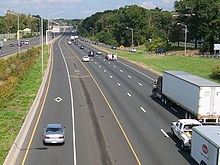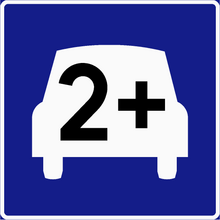High-occupancy vehicle lane


A high-occupancy vehicle lane (translated lane for heavy vehicles took just HOV lane even carpool lane , so carpool lane ) is a motor vehicle lanes in the United States and Canada , the formation of carpools to promote. Only vehicles with at least two occupants, sometimes at least three people, are allowed to drive on such a lane. Alternative names for such lanes are commuter lane , diamond lane , express lane and transit lane .
history
After the 1973 oil crisis , considerations began in the USA as to how to counter the growing energy consumption from traffic and air pollution. It was claimed that there would be no more traffic jams if there were 1.3 or more passengers in the vehicles . In order to create an incentive for the formation of car pools, HOV lanes were introduced in the American traffic system from the beginning of the 1980s .
use
The HOV lanes may only be used if a minimum number of people are in the vehicle concerned. Usually two people are required ( HOV-2 would be on the road sign ). In metropolitan areas (e.g. Los Angeles ) there are also lanes where at least 3 ( HOV-3 ) or more people must be in the vehicle. There are even HOV-4 lanes in New York . These lanes are usually less traveled, so that you can get there much faster. In addition, the maximum permissible speed on these lanes is often higher than on the others. Improper use of these lanes (i.e. when driving with fewer passengers than prescribed) is punishable by very high fines.
In California , individual drivers have recently been allowed to use the HOV lanes if their vehicle falls below specified emissions or consumption values. This is documented with a clean air sticker . The US government has plans to implement this concept in the other states as well.
- HOV / HOT
Another type of use are HOT lanes ( high-occupancy toll lanes ). The difference to the HOV lanes is that SOV (single-occupant vehicle) are allowed to use the lane for a toll fee. To keep traffic flowing in these lanes, the United States has increased or decreased tolls on around 75 percent of these routes, depending on the volume of traffic. While many states in the United States have advocated an upper price cap of around US $ 10, there are states such as Virginia , where the toll can rise indefinitely. On February 28, 2018, it hit a new record of $ 47.50 for a 10-mile segment. The other HOT lanes in the USA have prices that are only varied over the day.
execution
HOV lanes are identified by diamond symbols on the lane and the associated traffic signs, from which the designation diamond lane is derived. The tracks are either designed as an extra track next to the others or they are completely structurally separated. Use only for carpooling is partially (not everywhere) limited to rush hour. During the rest of the time, the lanes can be used by all road users ( open to all traffic ).
In the case of the structurally separate carriageways, it is also possible that the direction of use is reversed. This means that the road can be set up as an entry or exit road as required (e.g. depending on the time of day) .
Success / criticism
A general assessment of the benefits of HOV lanes is not possible due to the different designs, the different regional traffic volumes and the respective infrastructure. However, it can be observed that the incentive to escape a traffic jam, especially in metropolitan areas, is conducive to the formation of car pools. For example, during rush hour, Interstate 66 can only be used by car pools to connect Washington to the suburbs. An investigation of an Express Lane on Interstate 405 in Washington state found that the average travel time on a 15-mile section when using Express Lane decreases by 11 minutes on a weekday. HOV lanes , which due to their low level of use (due to the infrastructural situation), sometimes make traffic jams even worse , are viewed critically .
Europe
In Europe, the Netherlands , Norway , Great Britain and Spain have introduced carpool lanes on an experimental basis. In Austria , a bus lane in the direction of Linz was released on the B 127 for the use of vehicles with three or more occupants. In Krakow ( Poland ), the extensive bus lanes were also opened for car pooling.
Web links
- Explanation of HOV lanes in Phoenix
- Investigation of the Karlsruhe Research Center on the effectiveness of carpooling based on US projects and experiences (PDF file; 55 kB)
swell
- ↑ History of the HOV lanes (English) ( Memento of the original from September 28, 2007 in the Internet Archive ) Info: The archive link was inserted automatically and has not yet been checked. Please check the original and archive link according to the instructions and then remove this notice.
- ↑ HOV-4 lanes in New York ( Memento from March 30, 2008 in the Internet Archive )
- ↑ Department of Motor Vehicles California (English)
- ↑ America is rethinking. In: sueddeutsche.de . May 17, 2010, accessed July 12, 2019 .
- ↑ a b Jack Roper: Smashing the limits - should tolling caps be abolished . In: Traffic Technology International . January 2019, p. 66-72 (English).
- ^ Virginia Department of Transportation

